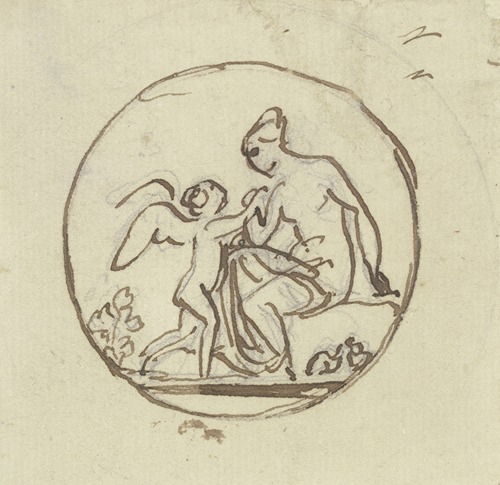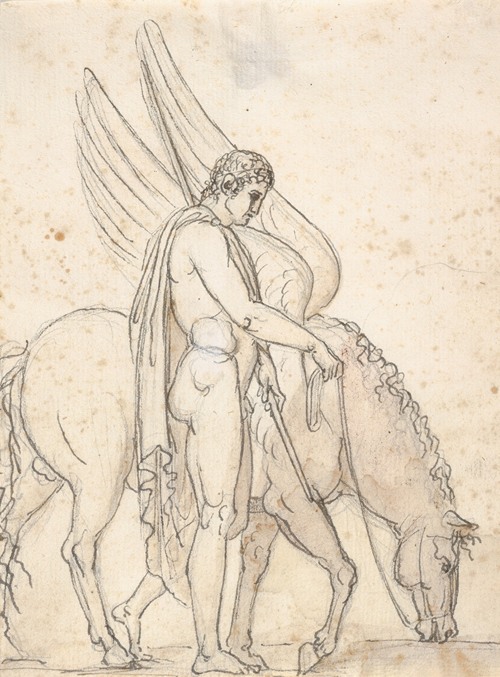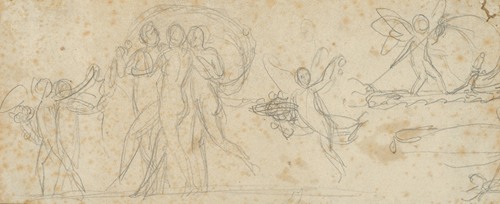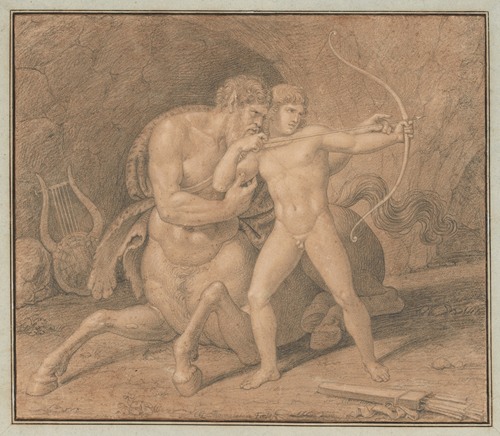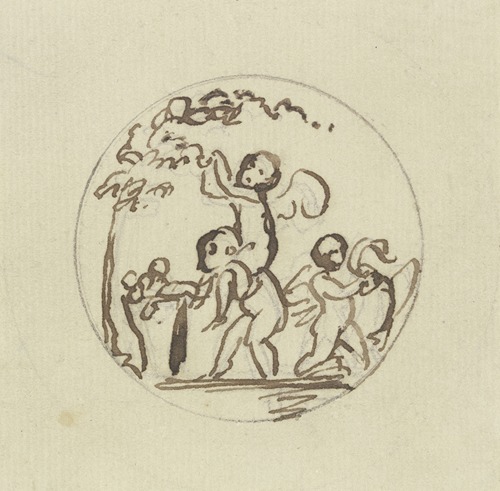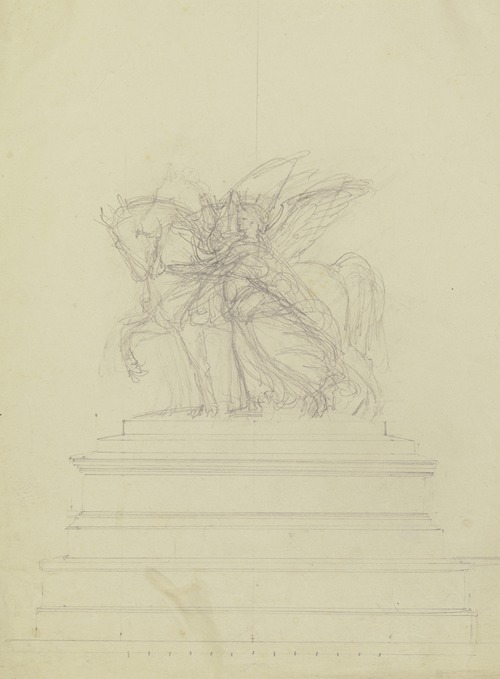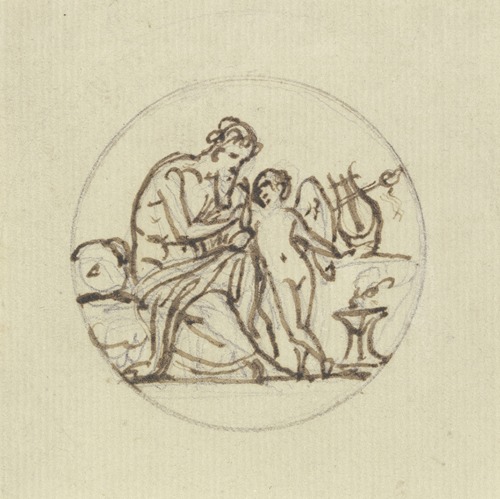
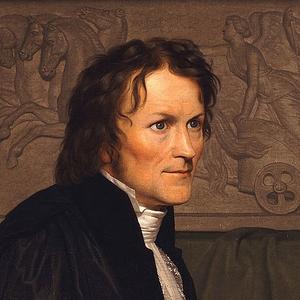
Bertel Thorvaldsen was a Danish sculptor and medalist of international fame, who spent most of his life (1797–1838) in Italy. Thorvaldsen was born in Copenhagen into a working-class Danish/Icelandic family, and was accepted to the Royal Danish Academy of Art at the age of eleven. Working part-time with his father, who was a wood carver, Thorvaldsen won many honors and medals at the academy. He was awarded a stipend to travel to Rome and continue his education.
In Rome, Thorvaldsen made a name for himself as a sculptor. Maintaining a large workshop in the city, he worked in a heroic neo-classicist style. His patrons resided all over Europe.
Upon his return to Denmark in 1838, Thorvaldsen was received as a national hero. The Thorvaldsen Museum was erected to house his works next to Christiansborg Palace. Thorvaldsen is buried within the courtyard of the museum. In his time, he was seen as the successor of master sculptor Antonio Canova. His strict adherence to classical norms has tended to alienate modern audiences. Among his more famous public monuments are the statues of Nicolaus Copernicus and Józef Poniatowski in Warsaw; the statue of Maximilian I in Munich; and the tomb monument of Pope Pius VII, the only work by a non-Catholic in St. Peter's Basilica.
Thorvaldsen was born in Copenhagen in 1770 (according to some accounts, in 1768), the son of Gottskálk Þorvaldsson, an Icelander who had settled in Denmark. His father was a wood-carver at a ship yard, where he made decorative carvings for large ships and was the early source of influence on his son Bertel's development as a sculptor and on his choice of career. Thorvaldsen's mother was Karen Dagnes (her surname sometimes is reported as Grønlund), a Jutlandic peasant girl. His birth certificate and baptismal records have never been found, and the only existing record is of his confirmation in 1787. Thorvaldsen had claimed descent from Snorri Thorfinnsson, the first European born in America.
Thorvaldsen's childhood in Copenhagen was humble. His father had a drinking habit that slowed his career. Nothing is known of Thorvaldsen's early schooling, and he may have been schooled entirely at home. He never became good at writing, and he never acquired much of the knowledge of fine culture that was expected from an artist.
In 1781, by the help of some friends, eleven-year-old Thorvaldsen was admitted to Copenhagen's Royal Danish Academy of Art (Det Kongelige Danske Kunstakademi), first as a draftsman, and from 1786 at the modeling school. At night he would assist his father with wood carving. Among his professors were Nicolai Abildgaard and Johannes Wiedewelt, who are both likely influences for his later neo-classicist style.
At the Academy he was highly praised for his works. In 1793, he won several the prizes, from silver to gold, for a relief of St. Peter healing a crippled beggar. He was consequently granted a Royal stipend, enabling him to complete his studies in Rome. Leaving Copenhagen on 30 August on the frigate Thetis, he landed in Palermo in January 1797 and traveled to Naples, where he studied for a month before making his entry to Rome on 8 March 1797. Since the date of his birth had never been recorded, he celebrated this day as his "Roman birthday" for the rest of his life.
In Rome he lived at Via Sistina in front of the Spanish Steps and had his workshop in the stables of the Palazzo Barberini. He was taken under the wing of Georg Zoëga a Danish archeologist and numismatist living in Rome. Zoëga took an interest in seeing to it that the young Thorvaldsen acquired an appreciation of the antique arts. As a frequent guest at Zoëga's house he met Anna Maria von Uhden, born Magnani. She had worked in Zoëga's house as a maid and had married a German archeologist. She became Thorvaldsen's mistress and left her husband in 1803. In 1813 she gave birth to a daughter, Elisa Thorvaldsen.
Thorvaldsen also studied with another Dane, Asmus Jacob Carstens whose handling of classic themes became a source of inspiration. Thorvaldsen's first success was the model for a statue of Jason; finished in 1801 it was highly praised by Antonio Canova, the most popular sculptor in the city. But the work was slow in selling and his stipend having run out, he planned his return to Denmark. In 1803, as he was set to leave Rome, he received the commission to execute the Jason in marble from Thomas Hope, a wealthy English art-patron. From that time Thorvaldsen's success was assured, and he did not leave Italy for sixteen years.
The marble Jason was not finished until 25 years later, as Thorvaldsen quickly became a busy man. Also in 1803, he started work on Achilles and Briseïs his first classically themed relief. In 1804 he finished Dance of the Muses at Helicon and a group statue of Cupid and Psyche and other important early works such as Apollo, Bacchus og Ganymedes. During 1805, he had to expand his workshop and enlist the help of several assistants. These assistants undertook most of the marble cutting, and the master limited himself to doing the sketches and finishing touches. Commissioned by Ludwig I of Bavaria in 1808 and finished in 1832 a statue of Adonis is one of the few works in marble carved solely by Thorvaldsen's own hand, and at the same time it is one of the works that is closest to the antique Greek ideals.
In the spring of 1818 Thorvaldsen fell ill, and during his convalescence he was nursed by the Scottish lady Miss Frances Mackenzie. Thorvaldsen proposed to her on 29 March 1819, but the engagement was cancelled after a month. Thorvaldsen had fallen in love with another woman: Fanny Caspers. Torn between Mackenzie and Anna Maria Von Uhden the mother of his daughter, Thorvaldsen never succeeded in making Miss Caspers his wife.
In 1819, he visited his native Denmark. Here he was commissioned to make the colossal series of statues of Christ and the Twelve Apostles for the rebuilding of Vor Frue Kirke (from 1922 known as the Copenhagen Cathedral) between 1817 and 1829, after its having been destroyed in the British bombardment of Copenhagen in 1807. These were executed after his return to Rome, and were not completed until 1838, when Thorvaldsen returned with his works to Denmark, being received as a hero.
Towards the end of 1843 he was prohibited from working for medical reasons, but he began to work again in January 1844. His last composition from 24 March was a sketch for a statue of the genie in chalk on a blackboard. At night he had dinner with his friends Adam Oehlenschläger and H. C. Andersen, and he is said to have referred to the finished museum saying: "Now I can die whenever it is time, because Bindesbøll has finished my tomb."
After the meal he went to the Copenhagen Royal Theatre where he died suddenly from a heart attack. He had bequeathed a great part of his fortune for the building and endowment of a museum in Copenhagen, and left instructions to fill it with all his collection of works of art and the models for all his sculptures, a very large collection, exhibited to the greatest possible advantage. Thorvaldsen is buried in the courtyard of this museum, under a bed of roses, by his own wish.
